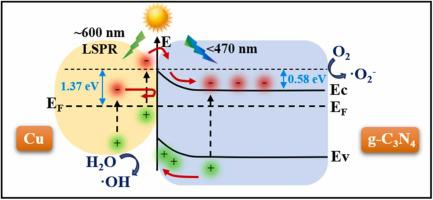当前位置:
X-MOL 学术
›
Catal. Today
›
论文详情
Our official English website, www.x-mol.net, welcomes your feedback! (Note: you will need to create a separate account there.)
Photocatalytic dye degradation by synergistically Cu LSPR and Schottky barrier enhanced Cu/g[sbnd]C3N4
Catalysis Today ( IF 5.3 ) Pub Date : 2024-03-30 , DOI: 10.1016/j.cattod.2024.114689 Mingze Xu , Guangjie Wang , Haiyu Li , Tingsong Zhang , Jinhua Li , Yu Wang , Yue Peng , Wenzhe Si
Catalysis Today ( IF 5.3 ) Pub Date : 2024-03-30 , DOI: 10.1016/j.cattod.2024.114689 Mingze Xu , Guangjie Wang , Haiyu Li , Tingsong Zhang , Jinhua Li , Yu Wang , Yue Peng , Wenzhe Si

|
The issue of water pollution has emerged as a formidable challenge, prompting a pressing need for solutions. The utilization of metal nanoparticles with surface plasmon resonance and semiconductor composite photocatalysts is regarded as a highly effective approach to solve this problem. gCN is an effective catalyst for the degradation of organic pollutants. Its photocatalytic performance could be enhanced by the use of the metal such as Au, Ag, and Cu. However, the Schottky barrier is generally believed to be the reason that Cu can enhances the photocatalytic performance of gCN. In fact, the plasmonic of Cu will also have an effect on the photocatalytic effect of gCN, like Au and Ag. In this study, it is first proposed that the photocatalytic performance of gCN can be enhanced by combining the plasmonic of Cu and the Schottky barrier. Cug/CN nanocomposites with stable crystal structure, with Cu as the core and gCN as surface coating, were synthesized and characterized by transmission electron microscopy (TEM), Xray diffractometer (XRD) and ultravioletvisible spectroscopy (UVVis) and Xray photoelectron spectroscopy (XPS). Then, it is optimized that the Cu/gCN composite material which were prepared with 200 nm Cu particles, GSH as the ligand bridge, and a Cu: gCN ratio of 5:1, have the best photocatalytic property, which is 16.7 times of the photocatalytic property of gCN. Besides, the transfer efficiency of hot electrons of 33% (from Cu to gCN) under the influence of the Schottky barrier (0.58 eV) is calculated theoretically. On this basis, the mechanism of Cu nanoparticles enhancing the photocatalytic performance of gCN was also been proved through the calculation result and transient photocurrent spectroscopy (TPC), electrochemical impedance spectroscopy (EIS), and steadystate transient fluorescence spectroscopy (PL) characterization. The excellent photocatalytic performance of the Cu/gCN composites is due to the simultaneous influence of Schottky barrier and LSPR of Cu.
中文翻译:

Cu LSPR 和肖特基势垒增强 Cu/g[sbnd]C3N4 协同光催化染料降解
水污染问题已成为一项艰巨的挑战,迫切需要解决方案。利用具有表面等离子体共振的金属纳米颗粒和半导体复合光催化剂被认为是解决这一问题的高效方法。 gCN是降解有机污染物的有效催化剂。通过使用金、银和铜等金属可以增强其光催化性能。然而,肖特基势垒通常被认为是Cu增强gCN光催化性能的原因。事实上,与Au和Ag一样,Cu的等离子体激元也会对gCN的光催化效果产生影响。在这项研究中,首次提出通过结合Cu的等离子体和肖特基势垒可以增强gCN的光催化性能。合成了以 Cu 为核心、gCN 为表面涂层、具有稳定晶体结构的 Cug/CN 纳米复合材料,并通过透射电子显微镜 (TEM)、X 射线衍射仪 (XRD)、紫外可见光谱 (UVVis) 和 X 射线光电子能谱 (XPS) 进行了表征。 。优化后发现,以200 nm Cu颗粒、GSH为配体桥、Cu:gCN比为5:1制备的Cu/gCN复合材料具有最佳的光催化性能,是普通材料的16.7倍。 gCN的光催化性能此外,理论上计算出在肖特基势垒(0.58 eV)影响下热电子转移效率为33%(从Cu到gCN)。在此基础上,通过计算结果和瞬态光电流谱(TPC)、电化学阻抗谱(EIS)和稳态瞬态荧光光谱(PL)表征,证明了Cu纳米颗粒增强gCN光催化性能的机制。 Cu/gCN复合材料优异的光催化性能得益于Cu的肖特基势垒和局域表面等离子体共振的同时影响。
更新日期:2024-03-30
中文翻译:

Cu LSPR 和肖特基势垒增强 Cu/g[sbnd]C3N4 协同光催化染料降解
水污染问题已成为一项艰巨的挑战,迫切需要解决方案。利用具有表面等离子体共振的金属纳米颗粒和半导体复合光催化剂被认为是解决这一问题的高效方法。 gCN是降解有机污染物的有效催化剂。通过使用金、银和铜等金属可以增强其光催化性能。然而,肖特基势垒通常被认为是Cu增强gCN光催化性能的原因。事实上,与Au和Ag一样,Cu的等离子体激元也会对gCN的光催化效果产生影响。在这项研究中,首次提出通过结合Cu的等离子体和肖特基势垒可以增强gCN的光催化性能。合成了以 Cu 为核心、gCN 为表面涂层、具有稳定晶体结构的 Cug/CN 纳米复合材料,并通过透射电子显微镜 (TEM)、X 射线衍射仪 (XRD)、紫外可见光谱 (UVVis) 和 X 射线光电子能谱 (XPS) 进行了表征。 。优化后发现,以200 nm Cu颗粒、GSH为配体桥、Cu:gCN比为5:1制备的Cu/gCN复合材料具有最佳的光催化性能,是普通材料的16.7倍。 gCN的光催化性能此外,理论上计算出在肖特基势垒(0.58 eV)影响下热电子转移效率为33%(从Cu到gCN)。在此基础上,通过计算结果和瞬态光电流谱(TPC)、电化学阻抗谱(EIS)和稳态瞬态荧光光谱(PL)表征,证明了Cu纳米颗粒增强gCN光催化性能的机制。 Cu/gCN复合材料优异的光催化性能得益于Cu的肖特基势垒和局域表面等离子体共振的同时影响。



























 京公网安备 11010802027423号
京公网安备 11010802027423号